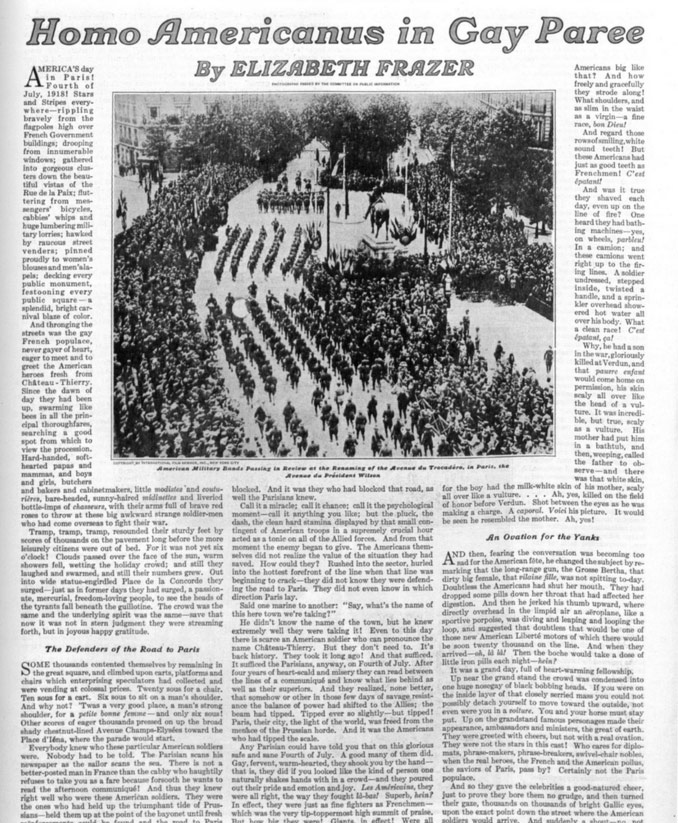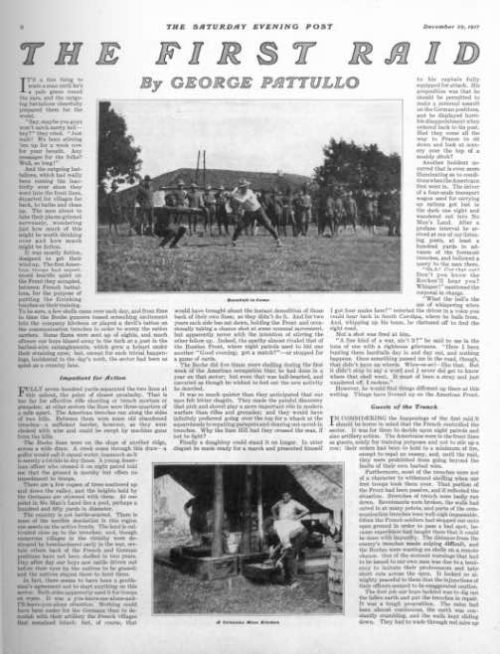When We Were Heroes
This excerpt is from the article “Homo Americanus in Gay Paree” by Elizabeth Frazer, which appeared in the November 2, 1918, issue of The Saturday Evening Post.
Suddenly a shout — no, not exactly a shout; rather, a big happy hurrah — burst simultaneously from thousands of grateful happy hearts. Here they come! Les Americains! Here they come! Strong emotion swept the crowd like a breeze. Vive l’Amerique! Vive les Americains!
And all that excited sea of souls laughed and cried and shouted and sobbed and rocked in glad exultation over these fine, big, clean garçons who had fought so splendidly, so desperately, so victoriously beside their own brave poilus.
It was American troops who stemmed the tide, who closed the road to Paris. They paid the price in blood, and the price was high. For that single episode showed both friends and foe where the war’s balance of power lay.
On they came, their bayonets glittering in the sun, their faces wreathed in smiles, their eyes — well, not quite straight dead ahead! For who can discipline his eyes, when a bombardment of roses or a barrage of violets hits one straight on the nose? There are garlands of roses round their necks, roses behind their ears, roses in their cartridge belts, roses in the nozzles of their guns, which lately spouted flame and shortly will again.
But today is Fourth of July in Paris! And these soldiers have earned this day of joy.

This article appears in the November/December 2018 issue of The Saturday Evening Post. Subscribe to the magazine for more art, inspiring stories, fiction, humor, and features from our archives.
100 Years Ago: The First Americans Killed in World War I
 On the night of November 3, 1917, German soldiers raided a trench in the French sector of the Western Front. However, this particular section of the trenches was held by American troops. There was intense fighting as the Germans surprised the Americans. When the fight was over, the Germans took 12 American soldiers back to their lines for interrogation. They left three Americans dead. In the year and nine days that remained of the war, those first American combat deaths would be followed by another 53,000, as well as 63,000 non-combat deaths, mostly from the influenza epidemic that swept through the trenches.
On the night of November 3, 1917, German soldiers raided a trench in the French sector of the Western Front. However, this particular section of the trenches was held by American troops. There was intense fighting as the Germans surprised the Americans. When the fight was over, the Germans took 12 American soldiers back to their lines for interrogation. They left three Americans dead. In the year and nine days that remained of the war, those first American combat deaths would be followed by another 53,000, as well as 63,000 non-combat deaths, mostly from the influenza epidemic that swept through the trenches.
George Pattullo, one of The Post’s war correspondents, reported on the deaths, and their comrades’ reaction to it. His December 29, 1917 article, “The First Raid,” is a rare, full account of what happened that night in northeastern France.
Despite the American losses, Pattullo was optimistic. The doughboys had stood their ground, he reported, refused to abandon wounded comrades, and fought back fiercely. Now, American soldiers who had been homesick and bored were eager to strike back at the Germans.
He wrote, “The raid of November third, small though it was, has welded the men of the First Division as no amount of training and discipline could do. The boys who came back from those trenches are a hundred per cent better soldiers than before they went. So are all their comrades.”

Featured image: Library of Congress